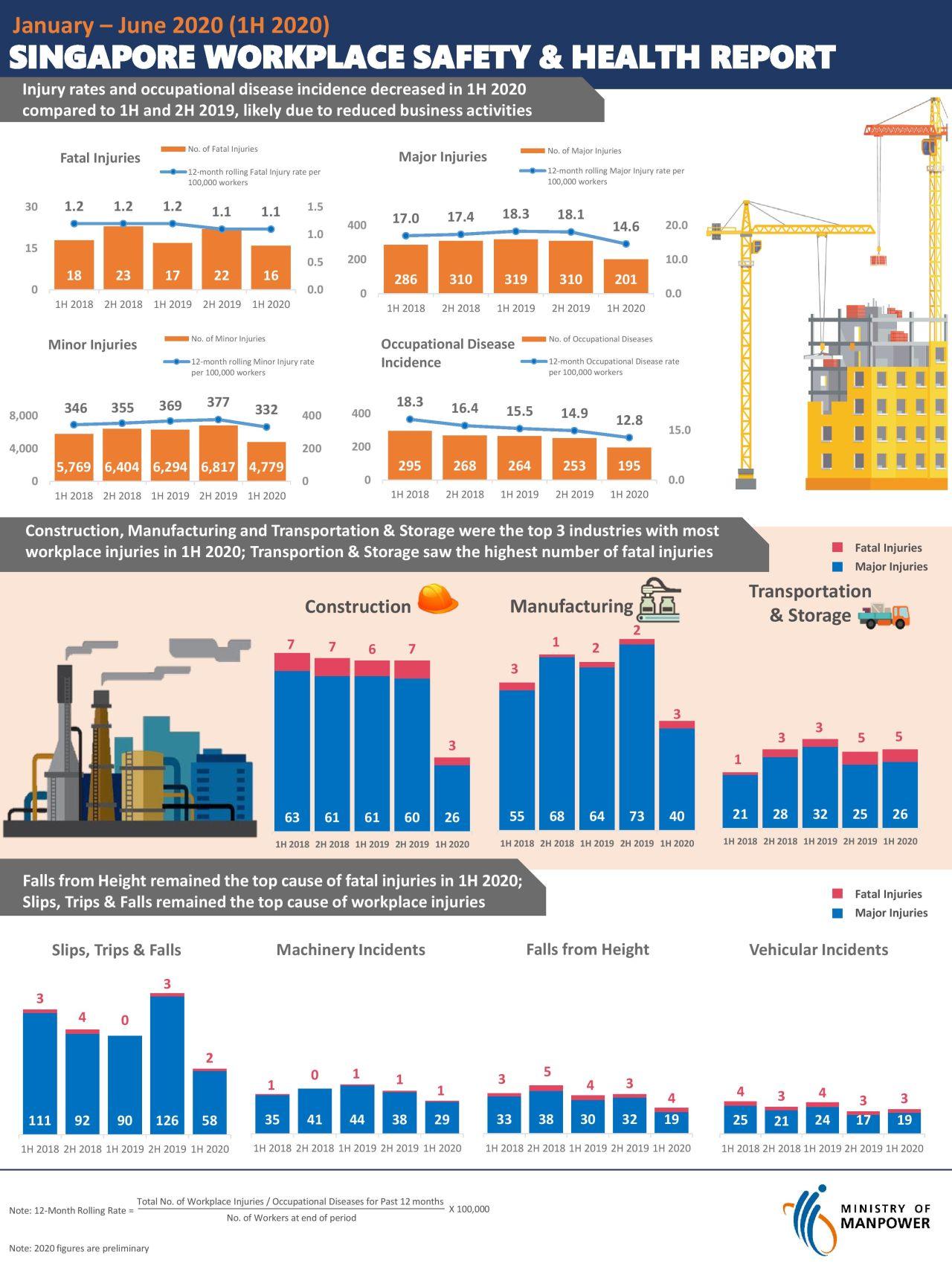share on
In the first half of 2020, the total number of occupational diseases (OD) fell by 26% - from 264 in H1 2019 to 195 in H1 2020. This was according to the latest statistics released by the Ministry of Manpower (MOM).
While the top two ODs have remained the same since H1 2019, the number of cases has dropped.
In H1 2020, the top two ODs were work-related musculoskeletal disorder (WRMSD) and noise-induced deafness (NID), which jointly account for 92% of all OD cases in H1 2020. When compared with H1 2019, the number of cases of WRMSD dropped from 145 in H1 2019 to 129 in H1 2020, while the number of cases of NID dropped from 90 to 50 in the same period.
25% fall in the overall number of workplace injuries, but fatal injury rate remained similar to that of end June 2019
MOM's statistics also showed a 25% fall in the overall number of workplace injuries - from 6,630 in the first half (H1) of 2019 to 4,996 in H1 2020. This is likely due to the suspension of certain workplace activities in 2Q 2020 due to COVID-19.
Despite a reduction of workplace activities due to COVID-19 in the second quarter (2Q) of 2020, there were 16 workplace fatalities in the H1 2020, similar to that in H1 2019 (17) and H1 2018 (18). This placed the 12-month rolling fatal injury rate at 1.1 per 100,000 workers as of end June 2020, similar to the rates as of end June 2019 and end December 2019.
Falls from height, as well as vehicular-related incidents, remain key concerns as the leading cause of fatalities in H1 2020. The former recorded four cases while there were three cases of the later in H1 2020.
In a Facebook post, NTUC Assistant Secretary-General Melvin Yong noted that high-risk sectors, such as transportation and construction, continue to account for the highest numbers of fatalities and injuries.
He said: "As more workers return to their workplaces, there is a need to ease them back gradually into their jobs, as many have not returned to their worksites for months. I urge companies to consider implementing a structured re-orientation programme for workers who have returned to work, especially in high-risk worksites, and to conduct refresher WSH (workplace safety and health) courses for all returning workers so that safety remains at the top of everyone's minds."
Number of fatalities highest in transportation & storage, construction, as well as manufacturing industries
According to MOM, the transportation & storage industry accounted for the highest number of fatalities (five cases) in H1 2020. Its 12-month fatality rate also increased from 3.1 per 100,000 workers as of end-December 2019 to 3.8 as of end-June 2020. At the same time, its total number of fatal and major injuries (31) remained similar to that in H1 2019 (35) and H2 2019 (30).
The second-highest contributor for fatal injuries in H1 2020 was the manufacturing industry, with three cases. The industry was also the top contributor for major and minor injuries in H1 2020, with 40 and 971 cases respectively.
‘Slips, trips and falls’ and ‘machinery-related incidents remain as leading causes of injuries
When it comes to major and minor incidents, ‘slips, trips and falls’ (STF) and ‘machinery-related incidents’ remained as leading causes, but the number of cases fell significantly
STF remained the top cause of both major and minor injuries. It accounted for 58 major injuries in H1 2020 (down from 90 in H1 2019) and 1,450 minor injuries in H1 2020 (down from 1,772 in H1 2019).
Machinery-related incidents continued to be the second-most common cause of major and minor injuries, with 29 machinery-related major injuries and 780 minor injuries in H1 2020, down from 44 and 1,075 respectively in H1 2019.
MOM also noted that the number of dangerous occurrences (DOs) fell from nine in H1 2019 to four in H1 2020 - where two were fire and explosion cases and the remaining two were crane-related incidents.
Moving forward, MOM will start progressively implementing the WSH 2028 strategy recommendations to sharpen the commercial impact on companies with unsafe practices.
For instance, from Q4 2020, the WSH performance of companies will be published, starting with construction companies. Criteria will also be introduced to disqualify unsafe contractors from all public construction tenders.
From 1 September 2020, employers have also been required to report all work accidents that result in medical leave or light duty. Additionally, employees on light duties due to work injuries are entitled to compensation for their lost earnings based on their Average Monthly Earnings (AME).
Commissioner for WSH and Divisional Director of MOM’s Occupational Safety and Health Division Mr Silas Sng said: “As companies restart, they must not rush to make up for lost time. Companies have invested much effort and resources through their Safe Management Measures to keep their workplace and workforce safe from COVID-19. It would be counterproductive if an accident occurs and workers are seriously injured. Workers’ lives are at stake, hence WSH must not be compromised.”
https://www.facebook.com/melvinyong.sg/posts/2447230802247001

Infographic / MOM's LinkedIn post
Photo / 123RF
Human Resources Online is on Telegram! Follow us @humanresourcesonline or click here for all the latest weekly HR and manpower news from around the region.
share on
Follow us on Telegram and on Instagram @humanresourcesonline for all the latest HR and manpower news from around the region!
Related topics

